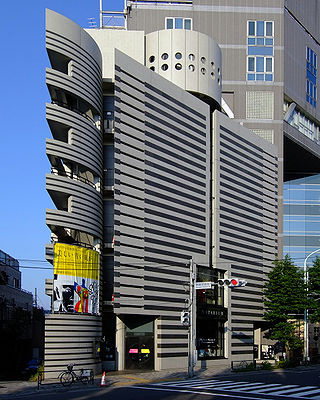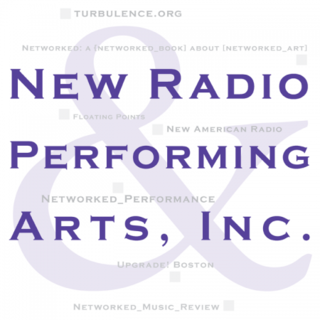Video art is an art form which relies on using video technology as a visual and audio medium. Video art emerged during the late 1960s as new consumer video technology such as video tape recorders became available outside corporate broadcasting. Video art can take many forms: recordings that are broadcast; installations viewed in galleries or museums; works streamed online, distributed as video tapes, or DVDs; and performances which may incorporate one or more television sets, video monitors, and projections, displaying live or recorded images and sounds.

Nam June Paik was a Korean artist. He worked with a variety of media and is considered to be the founder of video art. He is credited with the first use (1974) of the term "electronic super highway" to describe the future of telecommunications.

The Kitchen is a non-profit, multi-disciplinary avant-garde performance and experimental art institution located at 512 West 19th Street, between Tenth and Eleventh Avenues in the Chelsea neighborhood of Manhattan, New York City. As the organization undergoes a multi-year renovation it is currently sited at a satellite loft space in the West Village located at 163B Bank Street, where exhibitions and performances are regularly held. It was founded in Greenwich Village in 1971 by Steina and Woody Vasulka, who were frustrated at the lack of an outlet for video art. The space takes its name from the original location, the kitchen of the Mercer Arts Center which was the only available place for the artists to screen their video pieces. Although first intended as a location for the exhibition of video art, The Kitchen soon expanded its mission to include other forms of art and performance. In 1974, The Kitchen relocated to a building at the corner of Wooster and Broome Streets in SoHo, and incorporated as a not-for-profit arts organization. In 1987 it moved to its current location.

Shigeko Kubota was a Japanese video artist, sculptor and avant-garde performance artist, who mostly lived in New York City. She was one of the first artists to adopt the portable video camera Sony Portapak in 1970, likening it to a "new paintbrush." Kubota is known for constructing sculptural installations with a strong DIY aesthetic, which include sculptures with embedded monitors playing her original videos. She was a key member and influence on Fluxus, the international group of avant-garde artists centered on George Maciunas, having been involved with the group since witnessing John Cage perform in Tokyo in 1962 and subsequently moving to New York in 1964. She was closely associated with George Brecht, Jackson Mac Low, John Cage, Joe Jones, Nam June Paik, and Ay-O, among other members of Fluxus. Kubota was deemed "Vice Chairman" of the Fluxus Organization by Maciunas.

The DeCordova Sculpture Park and Museum is a sculpture park and contemporary art museum on the southern shore of Flint's Pond in Lincoln, Massachusetts, 20 miles northwest of Boston. It was established in 1950, and is the largest park of its kind in New England, encompassing 30 acres.
Paul Garrin is an interdisciplinary artist and social entrepreneur whose work explores the social impact of technology and issues of media access, free speech, public/private space, and the digital divide. Starting as his assistant in 1981, Garrin eventually emerged as one of the most important collaborators of video art superstar Nam June Paik, working closely together from 1982 to 1996.

The Block Museum of Art is a free public art museum located on the campus of Northwestern University in Evanston, Illinois. The Block Museum was established in 1980 when Chicago art collectors Mary and Leigh B. Block donated funds to Northwestern University for the construction of an art exhibition venue. In recognition of their gift, the university named the changing exhibition space the Mary and Leigh Block Gallery. The original conception of the museum was modeled on the German kunsthalle tradition, with no permanent collection, and a series of changing temporary exhibits. However, the Block Museum soon began to acquire a permanent collection as the university transferred many of its art pieces to the museum. In recognition of its growing collection and its expanding programming, the Gallery became the American Alliance of Museums accredited Mary and Leigh Block Museum of Art in 1998. The Block embarked on a major reconstruction project in 1999 and reopened in a new facility in September 2000.
Richard Humann is a New York City-based American neo-conceptual artist. His art delves deep into concept and ideas, and he uses a multitude of materials to create his installations, sculptures, videos, and sound projects. Richard Humann's influences are as broad ranging as from Donald Judd, and Nam June Paik, to Jonathan Borofsky. His artwork bears conceptual similarities and to that of Joseph Kosuth, Sol LeWitt, Lawrence Weiner, Edward Ruscha, and Robert Morris.
New Langton Arts was a not-for-profit arts organization focusing on contemporary art founded in 1975 and located the South of Market neighborhood in San Francisco, California. Part of the first wave of alternative art spaces in the United States, and New Langton Arts was a leader in exhibiting new media forms in art and involving artists in the decision-making process. Its first directors were Judy Moran and Renny Pritikin.

The Watari Museum of Contemporary Art (ワタリウム美術館), commonly referred to as Watari-um, is a museum of contemporary art located in Shibuya, Tokyo. Founded by Shizuko Watari and opened in 1990, the museum is near Gaienmae Station on the Tokyo Metro Ginza Line.
Craft Contemporary, formerly the Craft and Folk Art Museum, is a non-profit, non-collecting arts museum dedicated to showcasing contemporary craft in Los Angeles, California. The museum is located on Los Angeles' Museum Row on Wilshire Boulevard, and across from the George C. Page Museum and La Brea Tar Pits. It is the only institution on the West Coast of the United States to focus exclusively on craft.
An alternative exhibition space is a space other than a traditional commercial venue used for the public exhibition of artwork. Often comprising a place converted from another use, such as a store front, warehouse, or factory loft, it is then made into a display or performance space for use by an individual or group of artists. According to art advisor Allan Schwartzman "alternative spaces were the center of American artistic life in the '70s."

New Radio and Performing Arts, Inc. (NRPA), and its satellite project Turbulence.org, was an American organization that commissioned and archived new and experimental radio art, sound art, net art and mixed reality art. It was founded in 1981 by Helen Thorington. In 2003, NRPA opened an office in Boston, Massachusetts. The organization closed in December 2017.
Electronic Arts Intermix (EAI) is a nonprofit arts organization that is a resource for video and media art. An advocate of media art and artists since 1971, EAI's core program is the distribution and preservation of a collection of over 3,500 new and historical video works by artists. EAI has supported the creation, exhibition, distribution and preservation of video art, and more recently, digital art projects.

Artists Space is a non-profit art gallery and arts organization first established at 155 Wooster Street in Soho, New York City. Founded in 1972 by Irving Sandler and Trudie Grace and funded by the New York State Council on the Arts (NYSCA), Artists Space provided an alternative support structure for young, emerging artists, separate from the museum and commercial gallery system. Artists Space has historically been engaged in critical dialogues surrounding institutional critique, racism, the AIDS crisis, and Occupy Wall Street.
Thomas Solomon is an American art dealer and curator who owns the Thomas Solomon Gallery in Los Angeles. Considered a "leading figure" in the Los Angeles art world, he represents 1960s and 1970s conceptual and emerging artists. He also provides art consulting services through Thomas Solomon Fine Art Advising. He is the son of New York City art collectors and patrons Horace and Holly Solomon.
Gallery Hyundai (Korean: 갤러리현대) is a contemporary art gallery in Seoul, South Korea. It was founded in 1970, initially in Insadong. It moved to Samcheong-ro, Sagan-dong in 1975.

Larry Miller is an American artist, most strongly linked to the Fluxus movement after 1969. He is "an intermedia artist whose work questions the borders between artistic, scientific and theological disciplines. He was in the vanguard of using DNA and genetic technologies as new art media." Electronic Arts Intermix, a pioneering international resource for video and new media art has said, "Miller has produced a diverse body of experimental art works as a key figure in the emergent installation and performance movements in New York in the 1970s... His installations and performances have integrated diverse mediums [sic] and materials."

Nam June Paik Art Center is an art gallery in Giheung-gu, Yongin, Seoul Capital Area, South Korea. It opened in 2008 and hosts both permanent and temporary exhibitions. It is named after the Korean American artist Nam June Paik, whose work is included in its permanent collection.
Vakki (Korean: 빠키) is a South Korean artist who runs "Papapapa Tamguso". Based on visual art, it is exploring various media such as stereoscopic installation, spatial art, and video work. Vakki is actively showing exhibitions at the National Museum of Modern and Contemporary Art, Paik Nam-joon Art Center, Daelim Museum's guseulmoa, Seoul Museum of Art, and Arco Art Theater, and many showcases, groups, and individual exhibitions have been held overseas in Berlin, Thailand, and New York. In addition, the field of visual arts is expanding by showing the writer's pleasant visual language through collaboration with cultural and artistic spaces, commercial brands, and fashion designers.